Taxation Law: Negative Gearing and Its Implications Assessment
VerifiedAdded on 2023/06/07
|6
|1904
|474
Report
AI Summary
This report delves into the concept of negative gearing within the framework of Australian taxation law. It elucidates the mechanics of negative gearing, where investment expenses, including interest on loans and depreciation, are offset against taxable income to reduce overall tax liability. The report examines the arguments for and against negative gearing, highlighting its popularity among investors, particularly high-income earners, and its potential impact on property prices and government revenue. It explores the debate surrounding the removal of negative gearing, discussing the potential consequences for investment, rental markets, and economic growth. The analysis incorporates various viewpoints, including those of academics and policymakers, to provide a comprehensive understanding of the complexities and implications of negative gearing in the Australian context, and its role in the broader economic landscape. The report also looks at the arguments in favor of and against negative gearing. It also discusses the impact of negative gearing on the property market and its potential implications for first-time homebuyers and the government revenue. The report concludes by emphasizing the need for a balanced approach to taxation policy that considers the interests of all stakeholders.
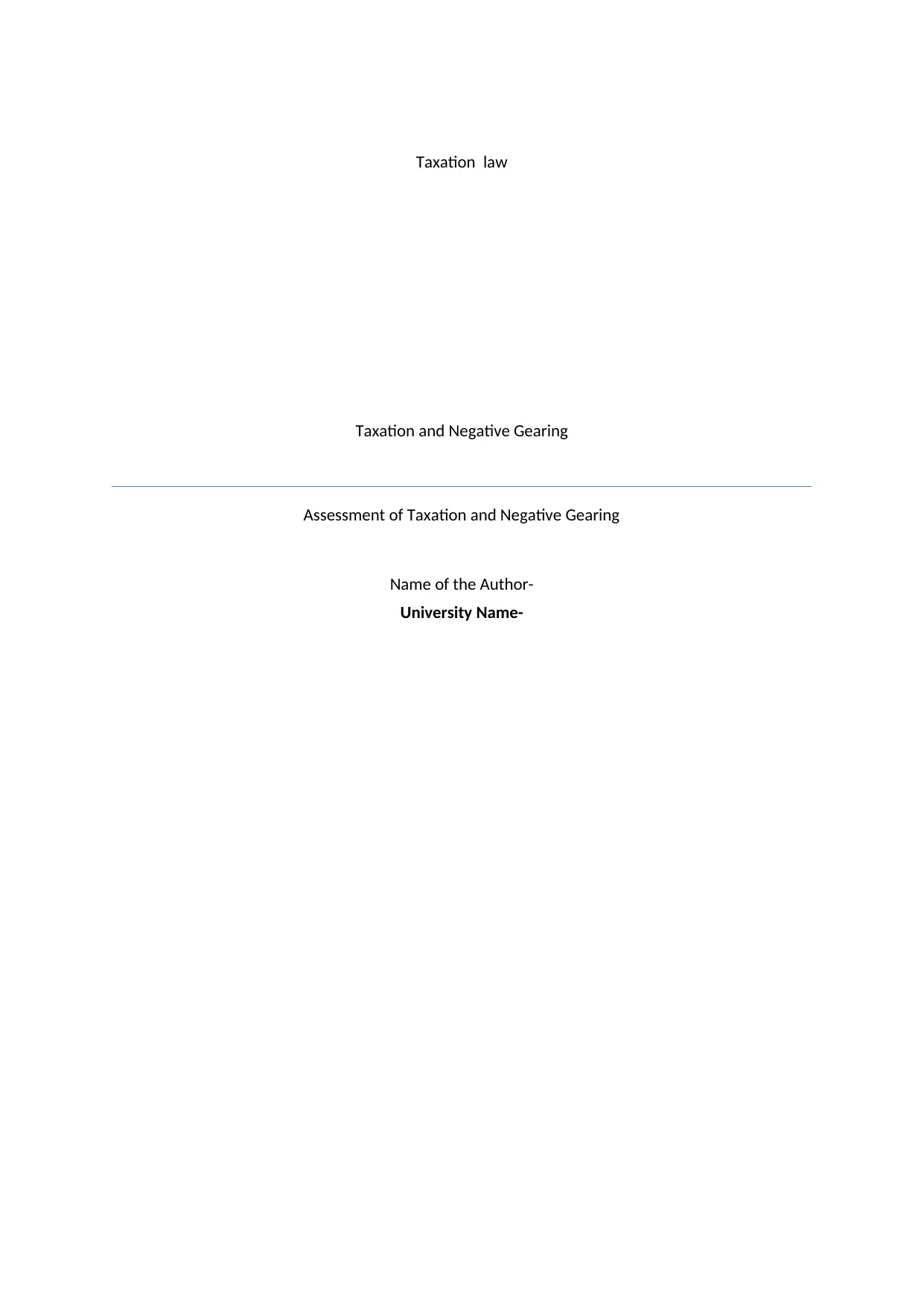
Taxation law
Taxation and Negative Gearing
Assessment of Taxation and Negative Gearing
Name of the Author-
University Name-
Taxation and Negative Gearing
Assessment of Taxation and Negative Gearing
Name of the Author-
University Name-
Paraphrase This Document
Need a fresh take? Get an instant paraphrase of this document with our AI Paraphraser
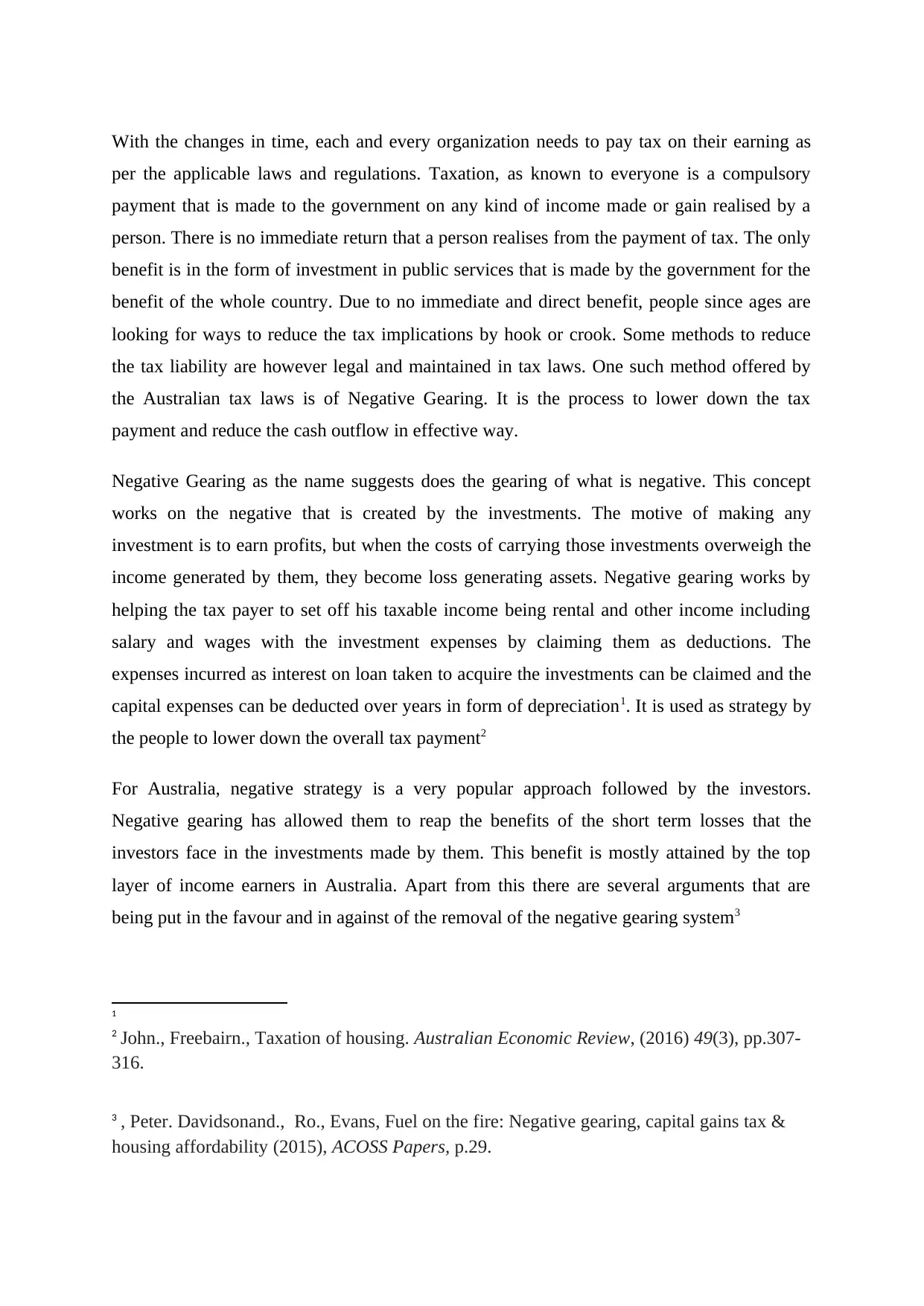
With the changes in time, each and every organization needs to pay tax on their earning as
per the applicable laws and regulations. Taxation, as known to everyone is a compulsory
payment that is made to the government on any kind of income made or gain realised by a
person. There is no immediate return that a person realises from the payment of tax. The only
benefit is in the form of investment in public services that is made by the government for the
benefit of the whole country. Due to no immediate and direct benefit, people since ages are
looking for ways to reduce the tax implications by hook or crook. Some methods to reduce
the tax liability are however legal and maintained in tax laws. One such method offered by
the Australian tax laws is of Negative Gearing. It is the process to lower down the tax
payment and reduce the cash outflow in effective way.
Negative Gearing as the name suggests does the gearing of what is negative. This concept
works on the negative that is created by the investments. The motive of making any
investment is to earn profits, but when the costs of carrying those investments overweigh the
income generated by them, they become loss generating assets. Negative gearing works by
helping the tax payer to set off his taxable income being rental and other income including
salary and wages with the investment expenses by claiming them as deductions. The
expenses incurred as interest on loan taken to acquire the investments can be claimed and the
capital expenses can be deducted over years in form of depreciation1. It is used as strategy by
the people to lower down the overall tax payment2
For Australia, negative strategy is a very popular approach followed by the investors.
Negative gearing has allowed them to reap the benefits of the short term losses that the
investors face in the investments made by them. This benefit is mostly attained by the top
layer of income earners in Australia. Apart from this there are several arguments that are
being put in the favour and in against of the removal of the negative gearing system3
1
2 John., Freebairn., Taxation of housing. Australian Economic Review, (2016) 49(3), pp.307-
316.
3 , Peter. Davidsonand., Ro., Evans, Fuel on the fire: Negative gearing, capital gains tax &
housing affordability (2015), ACOSS Papers, p.29.
per the applicable laws and regulations. Taxation, as known to everyone is a compulsory
payment that is made to the government on any kind of income made or gain realised by a
person. There is no immediate return that a person realises from the payment of tax. The only
benefit is in the form of investment in public services that is made by the government for the
benefit of the whole country. Due to no immediate and direct benefit, people since ages are
looking for ways to reduce the tax implications by hook or crook. Some methods to reduce
the tax liability are however legal and maintained in tax laws. One such method offered by
the Australian tax laws is of Negative Gearing. It is the process to lower down the tax
payment and reduce the cash outflow in effective way.
Negative Gearing as the name suggests does the gearing of what is negative. This concept
works on the negative that is created by the investments. The motive of making any
investment is to earn profits, but when the costs of carrying those investments overweigh the
income generated by them, they become loss generating assets. Negative gearing works by
helping the tax payer to set off his taxable income being rental and other income including
salary and wages with the investment expenses by claiming them as deductions. The
expenses incurred as interest on loan taken to acquire the investments can be claimed and the
capital expenses can be deducted over years in form of depreciation1. It is used as strategy by
the people to lower down the overall tax payment2
For Australia, negative strategy is a very popular approach followed by the investors.
Negative gearing has allowed them to reap the benefits of the short term losses that the
investors face in the investments made by them. This benefit is mostly attained by the top
layer of income earners in Australia. Apart from this there are several arguments that are
being put in the favour and in against of the removal of the negative gearing system3
1
2 John., Freebairn., Taxation of housing. Australian Economic Review, (2016) 49(3), pp.307-
316.
3 , Peter. Davidsonand., Ro., Evans, Fuel on the fire: Negative gearing, capital gains tax &
housing affordability (2015), ACOSS Papers, p.29.
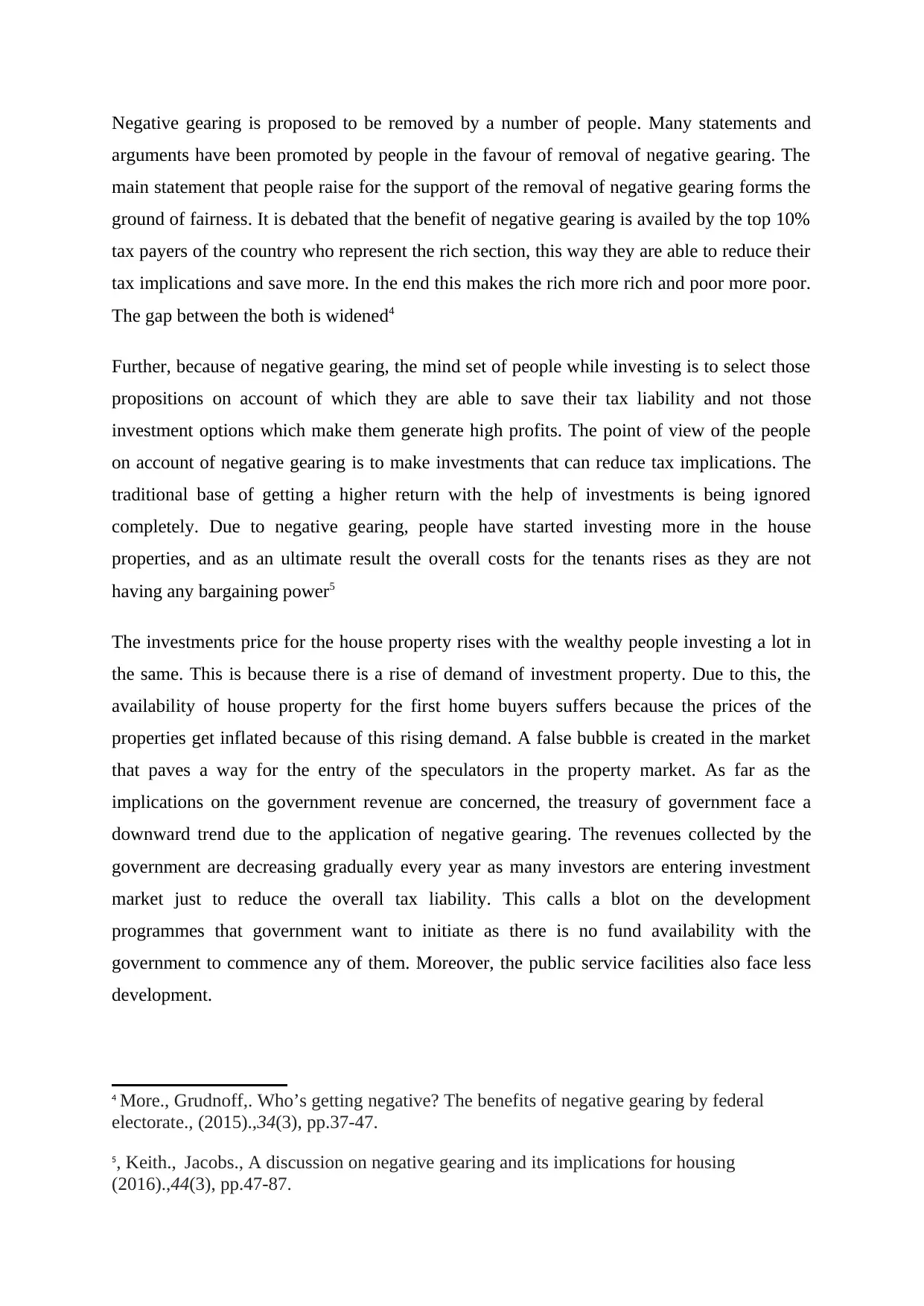
Negative gearing is proposed to be removed by a number of people. Many statements and
arguments have been promoted by people in the favour of removal of negative gearing. The
main statement that people raise for the support of the removal of negative gearing forms the
ground of fairness. It is debated that the benefit of negative gearing is availed by the top 10%
tax payers of the country who represent the rich section, this way they are able to reduce their
tax implications and save more. In the end this makes the rich more rich and poor more poor.
The gap between the both is widened4
Further, because of negative gearing, the mind set of people while investing is to select those
propositions on account of which they are able to save their tax liability and not those
investment options which make them generate high profits. The point of view of the people
on account of negative gearing is to make investments that can reduce tax implications. The
traditional base of getting a higher return with the help of investments is being ignored
completely. Due to negative gearing, people have started investing more in the house
properties, and as an ultimate result the overall costs for the tenants rises as they are not
having any bargaining power5
The investments price for the house property rises with the wealthy people investing a lot in
the same. This is because there is a rise of demand of investment property. Due to this, the
availability of house property for the first home buyers suffers because the prices of the
properties get inflated because of this rising demand. A false bubble is created in the market
that paves a way for the entry of the speculators in the property market. As far as the
implications on the government revenue are concerned, the treasury of government face a
downward trend due to the application of negative gearing. The revenues collected by the
government are decreasing gradually every year as many investors are entering investment
market just to reduce the overall tax liability. This calls a blot on the development
programmes that government want to initiate as there is no fund availability with the
government to commence any of them. Moreover, the public service facilities also face less
development.
4 More., Grudnoff,. Who’s getting negative? The benefits of negative gearing by federal
electorate., (2015).,34(3), pp.37-47.
5, Keith., Jacobs., A discussion on negative gearing and its implications for housing
(2016).,44(3), pp.47-87.
arguments have been promoted by people in the favour of removal of negative gearing. The
main statement that people raise for the support of the removal of negative gearing forms the
ground of fairness. It is debated that the benefit of negative gearing is availed by the top 10%
tax payers of the country who represent the rich section, this way they are able to reduce their
tax implications and save more. In the end this makes the rich more rich and poor more poor.
The gap between the both is widened4
Further, because of negative gearing, the mind set of people while investing is to select those
propositions on account of which they are able to save their tax liability and not those
investment options which make them generate high profits. The point of view of the people
on account of negative gearing is to make investments that can reduce tax implications. The
traditional base of getting a higher return with the help of investments is being ignored
completely. Due to negative gearing, people have started investing more in the house
properties, and as an ultimate result the overall costs for the tenants rises as they are not
having any bargaining power5
The investments price for the house property rises with the wealthy people investing a lot in
the same. This is because there is a rise of demand of investment property. Due to this, the
availability of house property for the first home buyers suffers because the prices of the
properties get inflated because of this rising demand. A false bubble is created in the market
that paves a way for the entry of the speculators in the property market. As far as the
implications on the government revenue are concerned, the treasury of government face a
downward trend due to the application of negative gearing. The revenues collected by the
government are decreasing gradually every year as many investors are entering investment
market just to reduce the overall tax liability. This calls a blot on the development
programmes that government want to initiate as there is no fund availability with the
government to commence any of them. Moreover, the public service facilities also face less
development.
4 More., Grudnoff,. Who’s getting negative? The benefits of negative gearing by federal
electorate., (2015).,34(3), pp.37-47.
5, Keith., Jacobs., A discussion on negative gearing and its implications for housing
(2016).,44(3), pp.47-87.
⊘ This is a preview!⊘
Do you want full access?
Subscribe today to unlock all pages.

Trusted by 1+ million students worldwide
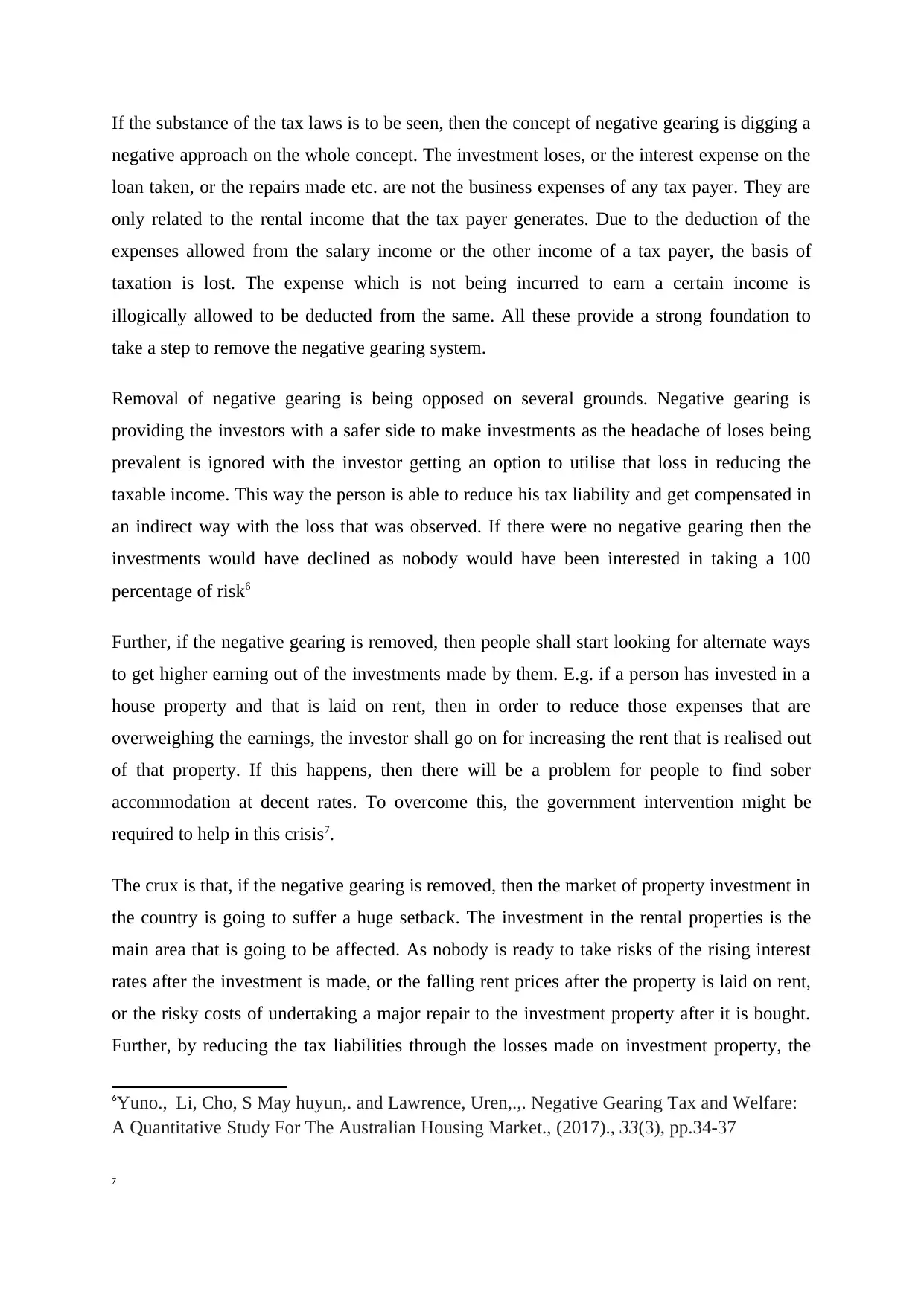
If the substance of the tax laws is to be seen, then the concept of negative gearing is digging a
negative approach on the whole concept. The investment loses, or the interest expense on the
loan taken, or the repairs made etc. are not the business expenses of any tax payer. They are
only related to the rental income that the tax payer generates. Due to the deduction of the
expenses allowed from the salary income or the other income of a tax payer, the basis of
taxation is lost. The expense which is not being incurred to earn a certain income is
illogically allowed to be deducted from the same. All these provide a strong foundation to
take a step to remove the negative gearing system.
Removal of negative gearing is being opposed on several grounds. Negative gearing is
providing the investors with a safer side to make investments as the headache of loses being
prevalent is ignored with the investor getting an option to utilise that loss in reducing the
taxable income. This way the person is able to reduce his tax liability and get compensated in
an indirect way with the loss that was observed. If there were no negative gearing then the
investments would have declined as nobody would have been interested in taking a 100
percentage of risk6
Further, if the negative gearing is removed, then people shall start looking for alternate ways
to get higher earning out of the investments made by them. E.g. if a person has invested in a
house property and that is laid on rent, then in order to reduce those expenses that are
overweighing the earnings, the investor shall go on for increasing the rent that is realised out
of that property. If this happens, then there will be a problem for people to find sober
accommodation at decent rates. To overcome this, the government intervention might be
required to help in this crisis7.
The crux is that, if the negative gearing is removed, then the market of property investment in
the country is going to suffer a huge setback. The investment in the rental properties is the
main area that is going to be affected. As nobody is ready to take risks of the rising interest
rates after the investment is made, or the falling rent prices after the property is laid on rent,
or the risky costs of undertaking a major repair to the investment property after it is bought.
Further, by reducing the tax liabilities through the losses made on investment property, the
6Yuno., Li, Cho, S May huyun,. and Lawrence, Uren,.,. Negative Gearing Tax and Welfare:
A Quantitative Study For The Australian Housing Market., (2017)., 33(3), pp.34-37
7
negative approach on the whole concept. The investment loses, or the interest expense on the
loan taken, or the repairs made etc. are not the business expenses of any tax payer. They are
only related to the rental income that the tax payer generates. Due to the deduction of the
expenses allowed from the salary income or the other income of a tax payer, the basis of
taxation is lost. The expense which is not being incurred to earn a certain income is
illogically allowed to be deducted from the same. All these provide a strong foundation to
take a step to remove the negative gearing system.
Removal of negative gearing is being opposed on several grounds. Negative gearing is
providing the investors with a safer side to make investments as the headache of loses being
prevalent is ignored with the investor getting an option to utilise that loss in reducing the
taxable income. This way the person is able to reduce his tax liability and get compensated in
an indirect way with the loss that was observed. If there were no negative gearing then the
investments would have declined as nobody would have been interested in taking a 100
percentage of risk6
Further, if the negative gearing is removed, then people shall start looking for alternate ways
to get higher earning out of the investments made by them. E.g. if a person has invested in a
house property and that is laid on rent, then in order to reduce those expenses that are
overweighing the earnings, the investor shall go on for increasing the rent that is realised out
of that property. If this happens, then there will be a problem for people to find sober
accommodation at decent rates. To overcome this, the government intervention might be
required to help in this crisis7.
The crux is that, if the negative gearing is removed, then the market of property investment in
the country is going to suffer a huge setback. The investment in the rental properties is the
main area that is going to be affected. As nobody is ready to take risks of the rising interest
rates after the investment is made, or the falling rent prices after the property is laid on rent,
or the risky costs of undertaking a major repair to the investment property after it is bought.
Further, by reducing the tax liabilities through the losses made on investment property, the
6Yuno., Li, Cho, S May huyun,. and Lawrence, Uren,.,. Negative Gearing Tax and Welfare:
A Quantitative Study For The Australian Housing Market., (2017)., 33(3), pp.34-37
7
Paraphrase This Document
Need a fresh take? Get an instant paraphrase of this document with our AI Paraphraser
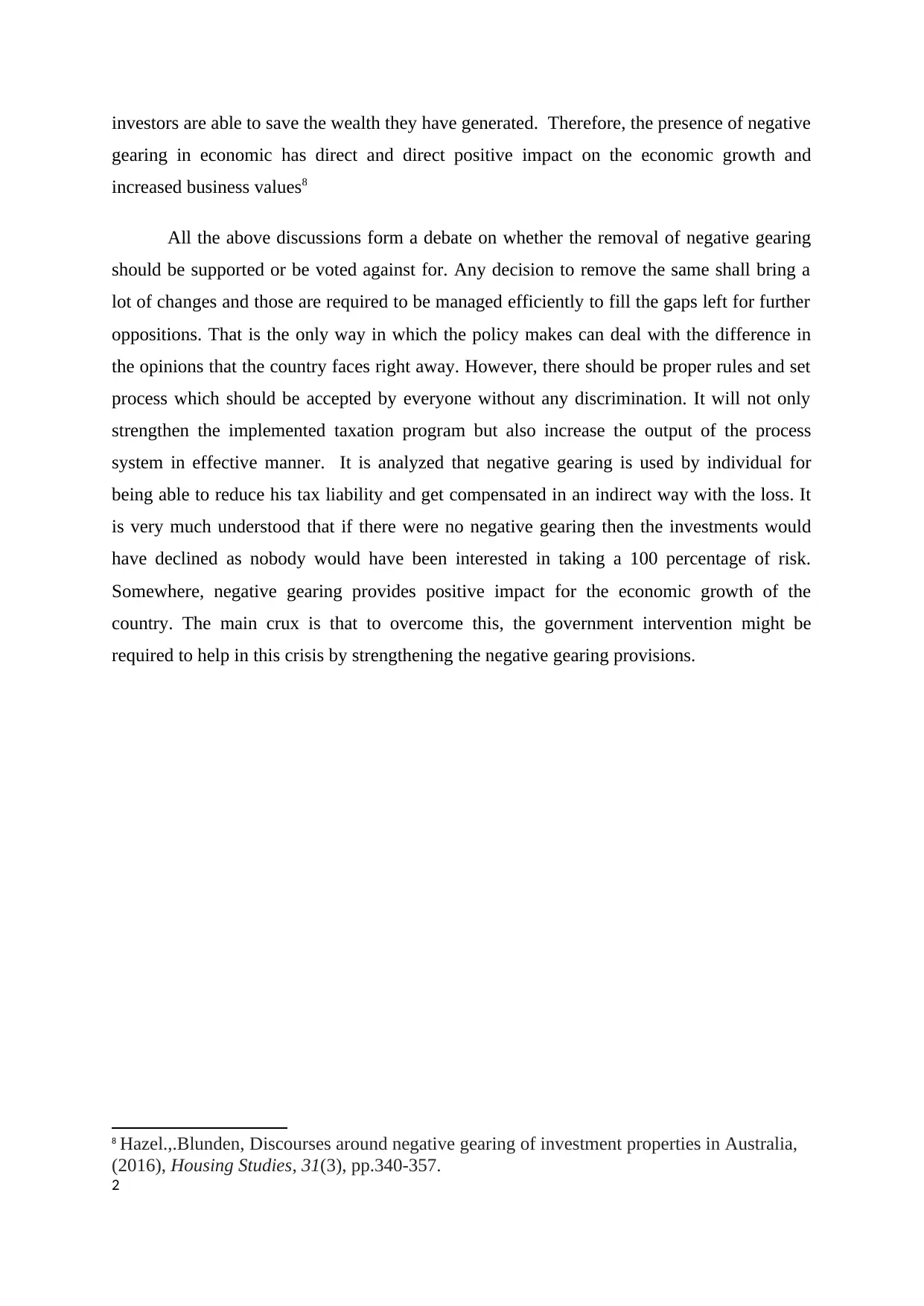
investors are able to save the wealth they have generated. Therefore, the presence of negative
gearing in economic has direct and direct positive impact on the economic growth and
increased business values8
All the above discussions form a debate on whether the removal of negative gearing
should be supported or be voted against for. Any decision to remove the same shall bring a
lot of changes and those are required to be managed efficiently to fill the gaps left for further
oppositions. That is the only way in which the policy makes can deal with the difference in
the opinions that the country faces right away. However, there should be proper rules and set
process which should be accepted by everyone without any discrimination. It will not only
strengthen the implemented taxation program but also increase the output of the process
system in effective manner. It is analyzed that negative gearing is used by individual for
being able to reduce his tax liability and get compensated in an indirect way with the loss. It
is very much understood that if there were no negative gearing then the investments would
have declined as nobody would have been interested in taking a 100 percentage of risk.
Somewhere, negative gearing provides positive impact for the economic growth of the
country. The main crux is that to overcome this, the government intervention might be
required to help in this crisis by strengthening the negative gearing provisions.
8 Hazel.,.Blunden, Discourses around negative gearing of investment properties in Australia,
(2016), Housing Studies, 31(3), pp.340-357.
2
gearing in economic has direct and direct positive impact on the economic growth and
increased business values8
All the above discussions form a debate on whether the removal of negative gearing
should be supported or be voted against for. Any decision to remove the same shall bring a
lot of changes and those are required to be managed efficiently to fill the gaps left for further
oppositions. That is the only way in which the policy makes can deal with the difference in
the opinions that the country faces right away. However, there should be proper rules and set
process which should be accepted by everyone without any discrimination. It will not only
strengthen the implemented taxation program but also increase the output of the process
system in effective manner. It is analyzed that negative gearing is used by individual for
being able to reduce his tax liability and get compensated in an indirect way with the loss. It
is very much understood that if there were no negative gearing then the investments would
have declined as nobody would have been interested in taking a 100 percentage of risk.
Somewhere, negative gearing provides positive impact for the economic growth of the
country. The main crux is that to overcome this, the government intervention might be
required to help in this crisis by strengthening the negative gearing provisions.
8 Hazel.,.Blunden, Discourses around negative gearing of investment properties in Australia,
(2016), Housing Studies, 31(3), pp.340-357.
2
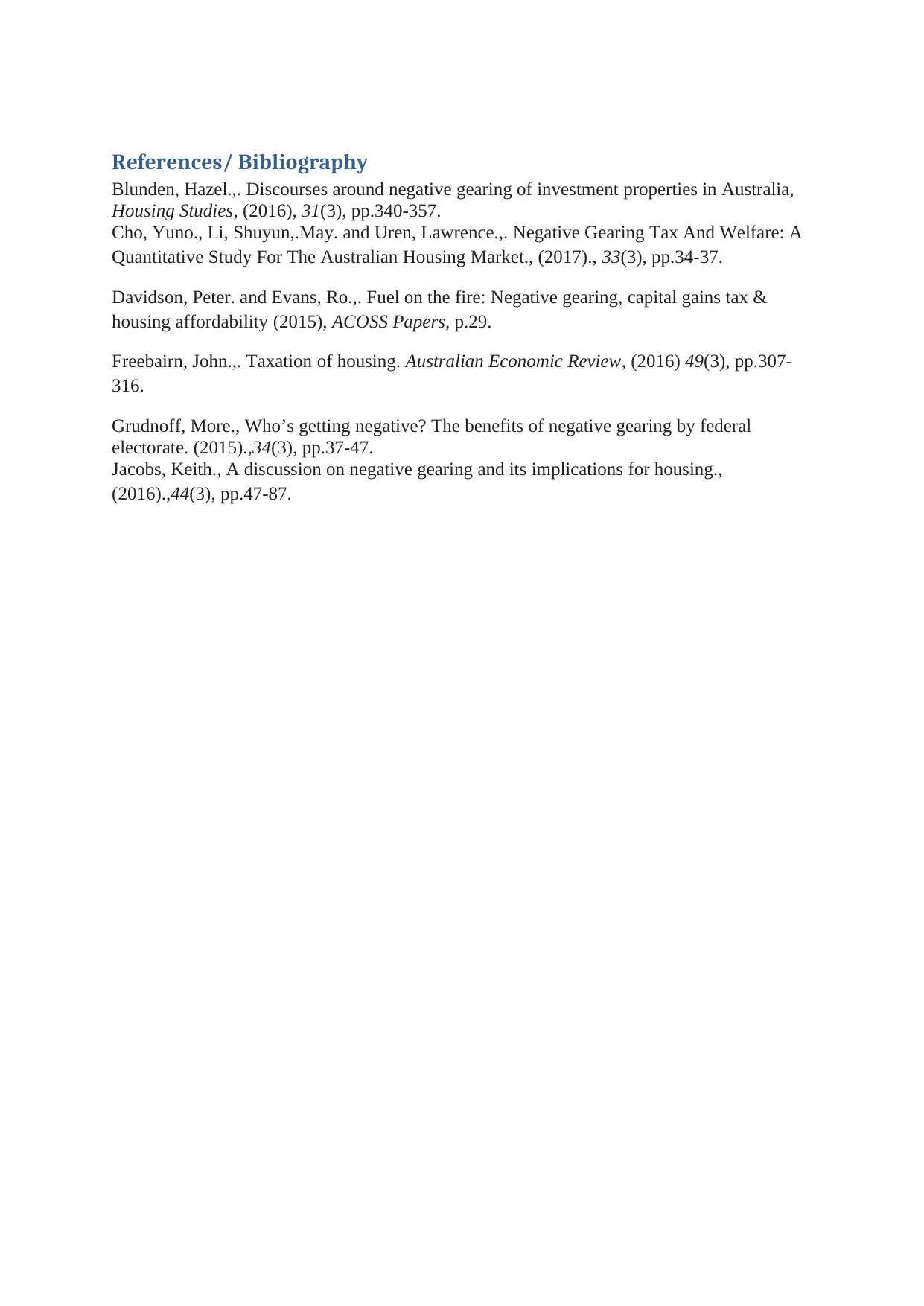
References/ Bibliography
Blunden, Hazel.,. Discourses around negative gearing of investment properties in Australia,
Housing Studies, (2016), 31(3), pp.340-357.
Cho, Yuno., Li, Shuyun,.May. and Uren, Lawrence.,. Negative Gearing Tax And Welfare: A
Quantitative Study For The Australian Housing Market., (2017)., 33(3), pp.34-37.
Davidson, Peter. and Evans, Ro.,. Fuel on the fire: Negative gearing, capital gains tax &
housing affordability (2015), ACOSS Papers, p.29.
Freebairn, John.,. Taxation of housing. Australian Economic Review, (2016) 49(3), pp.307-
316.
Grudnoff, More., Who’s getting negative? The benefits of negative gearing by federal
electorate. (2015).,34(3), pp.37-47.
Jacobs, Keith., A discussion on negative gearing and its implications for housing.,
(2016).,44(3), pp.47-87.
Blunden, Hazel.,. Discourses around negative gearing of investment properties in Australia,
Housing Studies, (2016), 31(3), pp.340-357.
Cho, Yuno., Li, Shuyun,.May. and Uren, Lawrence.,. Negative Gearing Tax And Welfare: A
Quantitative Study For The Australian Housing Market., (2017)., 33(3), pp.34-37.
Davidson, Peter. and Evans, Ro.,. Fuel on the fire: Negative gearing, capital gains tax &
housing affordability (2015), ACOSS Papers, p.29.
Freebairn, John.,. Taxation of housing. Australian Economic Review, (2016) 49(3), pp.307-
316.
Grudnoff, More., Who’s getting negative? The benefits of negative gearing by federal
electorate. (2015).,34(3), pp.37-47.
Jacobs, Keith., A discussion on negative gearing and its implications for housing.,
(2016).,44(3), pp.47-87.
⊘ This is a preview!⊘
Do you want full access?
Subscribe today to unlock all pages.

Trusted by 1+ million students worldwide
1 out of 6
Related Documents
Your All-in-One AI-Powered Toolkit for Academic Success.
+13062052269
info@desklib.com
Available 24*7 on WhatsApp / Email
![[object Object]](/_next/static/media/star-bottom.7253800d.svg)
Unlock your academic potential
Copyright © 2020–2025 A2Z Services. All Rights Reserved. Developed and managed by ZUCOL.



